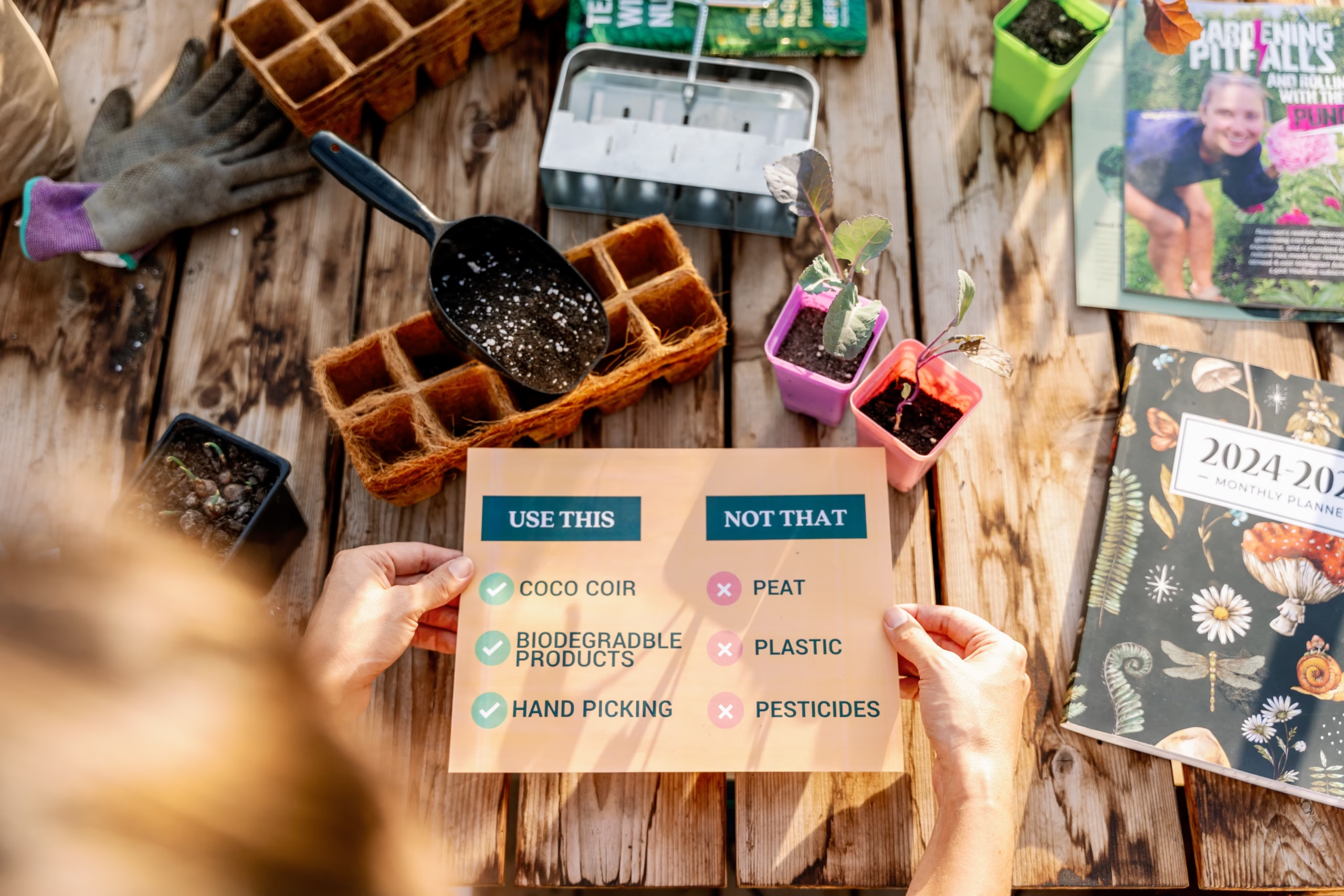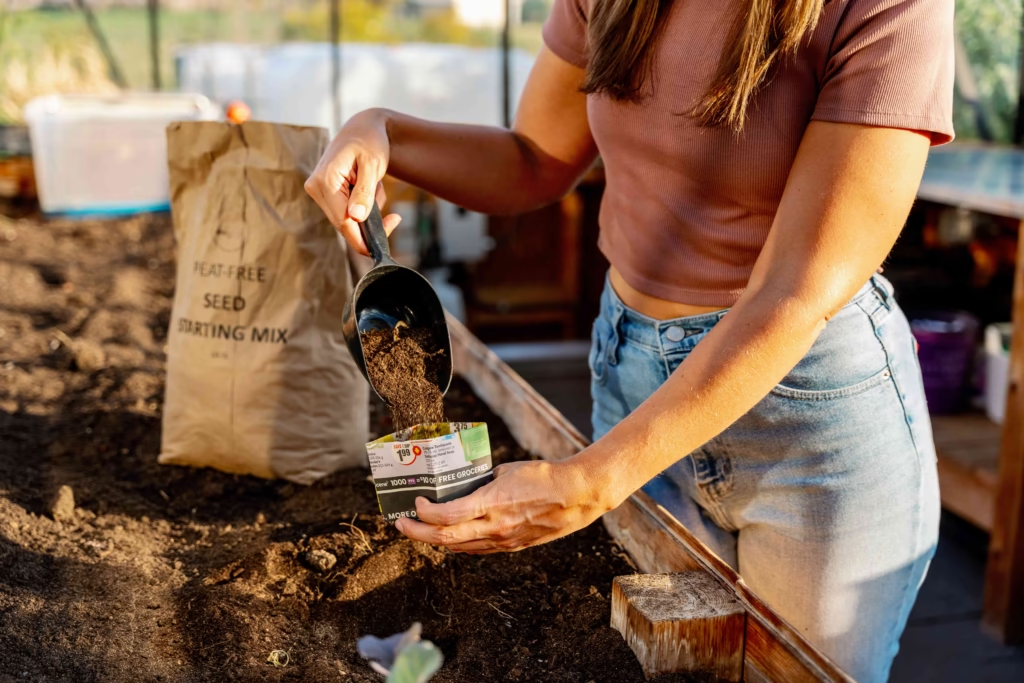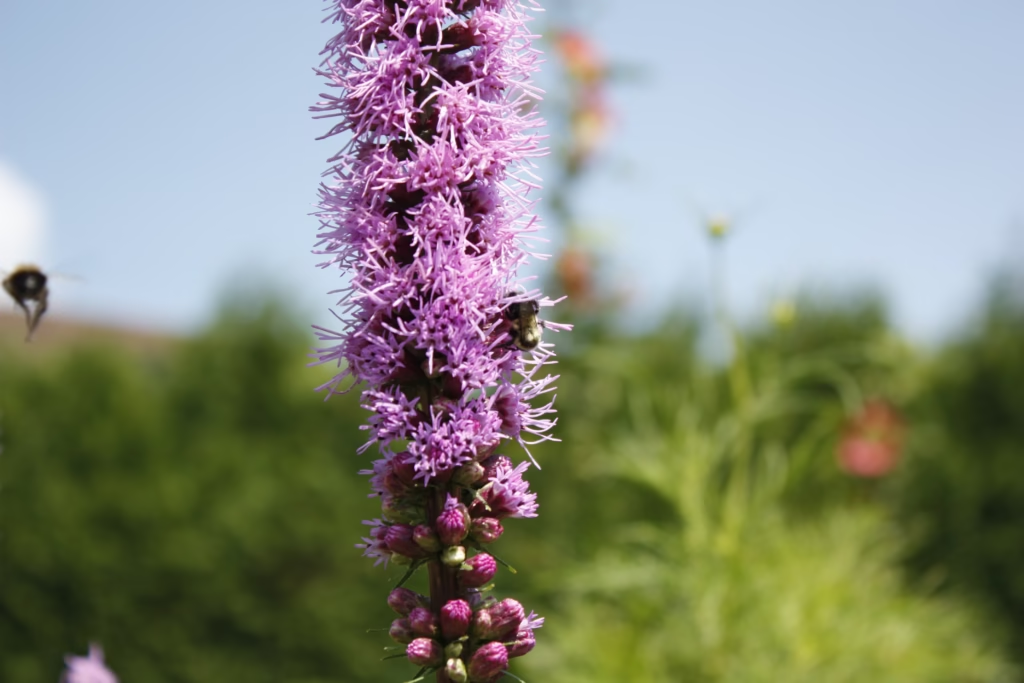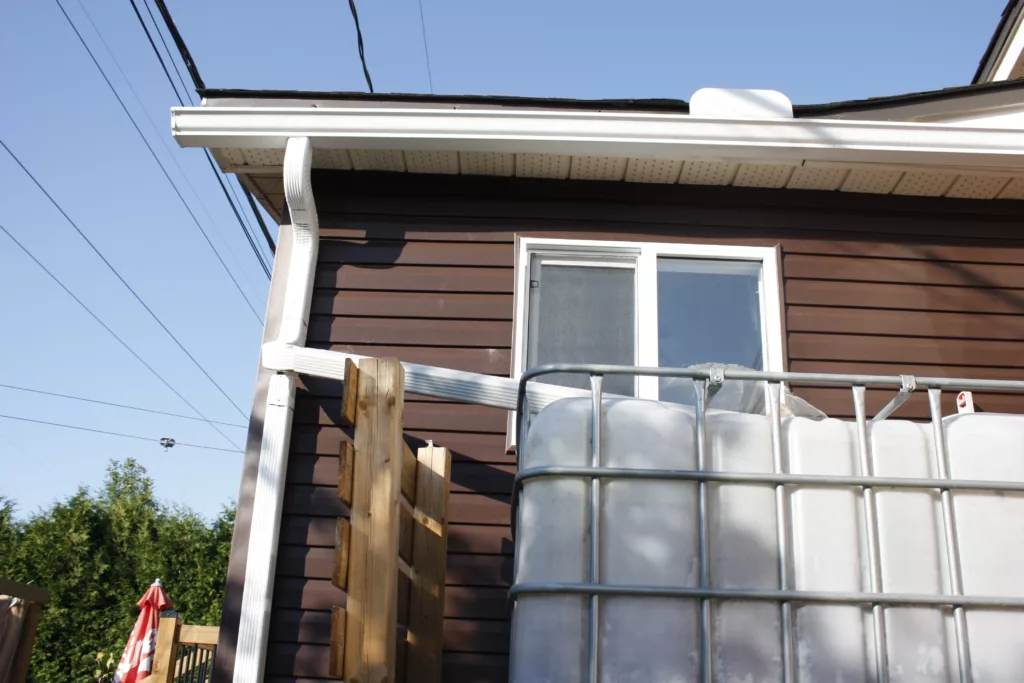

It’s easy to think that gardening is an environmentally hobby since your time is spent with plants. But the truth is that the garden and greenhouse industry uses a lot of unsustainable practices. From single-use black plastic pots, to pesticides sprayed on pollinator-friendly plants, there’s a lot of work that can be done to make the industry better for the environment.
While you can petition your local greenhouse to change their ways, you also have the ability to make your garden a more sustainable place. It’s simple to do with some minor swaps, and it won’t break the bank.

Our blog is reader supported. Some of the links in this article are affiliates that earn us a commission at no extra cost to you. Thanks for supporting our small business!
Peat extraction is actually terrible for the planet. Peat comes from wetlands, bogs or peatbogs and is extracted and heavily used in the horticulture/gardening world. It’s found in almost every soil blend, it’s used to make pots and for other seed starting products. Wetlands are a major carbon sink and hold more carbon than the global forests combined. Beyond killing an ecosystem that birds, bugs and animals rely on, when peat is dug up it releases carbon into the atmosphere.
But thankfully there’s alternatives that can replace peat. Although it hasn’t made it’s way here to North America, peat-free soil is gaining popularity in the UK. But since we don’t have easy options, the best way to replace peat as a home gardener is to look for blends that don’t include it, ask your local greenhouse or bulk soil company to bring in mixes that exclude peat, and also make your own peat-free seed starting blend for seed sowing season.
Another simple swap is to stop using any peat pots or peat pellets and switch to newspaper pots, soil blockers, or high quality plastic pots. If you’re newer to growing from seed and currently use peat pellets for seed starting, or were thinking of using them, I strongly suggest avoiding them for two reasons. The first is that, of course, they are made of peat. But second, they’re wrapped in a plastic netting that stunts the growth of your plants and it’s adding microplastics to your soil.
Plastic is everywhere! It’s nearly impossible to avoid, and the gardening world hasn’t been spared from it. Plastic pots, plastic shovels, plastic gloves, plastic jugs, plastic labels. Plastic, plastic, plastic.
Thankfully there’s alternatives out there, but the first step is looking around and realizing just how much plastic we use in our gardens. Most plastics never get recycled, and in fact break down into microplastics that get in our soil, and end up in our bodies. And our bodies weren’t built to digest and process plastic which means that we’re storing plastic in our bodies to the tune of an entire credit cards worth.
Unfortunately the gardening industry also loves its black plastic. But black plastic can’t be recycled – due to its colour – which means that it’s being melted down and mixed with harmful chemicals.
But thankfully we have options. Similar to peat, swap your plastic pots for newspaper pots or a soil blocker. Label your plants with popsicle sticks, and tie up your garden plants with sisal rope. Look for garden tools that are quality tools, made of metal that will last you a lifetime, rather than a plastic tool that will break after a couple of years. Most plastic isn’t built to sit out in UV light which breaks it down further. And it’s common for us gardeners to leave our tools laying around the yard. Investing in quality tools now will save you money down the road while keeping plastic out of the landfill.

Gardening became super popular on social media when the pandemic hit, and with the popularity came a wide assortment of trends. From rotting banana peels to copper poles in your garden there wasn’t much that wasn’t shared. Unfortunately, a lot of these trends use unsustainable products.
The two trends that come to the top of my mind is winter sowing in plastic jugs and using plastic packaging for “seed snails”.
Many fans of winter sowing say they do this method because they don’t have space in their house to start plants from seed. And it’s not the winter sowing itself that I have a problem with – it’s the fact that they are being sown in plastic jugs that aren’t made to sit through extreme temperature changes and UV light. As they sit outside the chemicals in the plastic break down, leaching into your soil and will soon become microplastics. If you’re winter sowing as a fun experiment, realize your harming the planet – and opt to direct sow seeds in your garden instead.
The most recent trend has been seed snails. This is when you use shipping plastics and lay soil on them, roll them up into a “snail” and then plant seeds on top. The theory is that the roots will grow directly down, you can unroll it and it’s an easy way to separate out seeds and grow in a small amount of space. I’ve even seen videos of people buying huge packaging rolls just to do this trend – what a waste!
Here at Urban Gardening Canada, we grow 1,000 seedlings every spring on a single 2×4 foot shelving unit. A shelving unit doesn’t take up much space (in fact it only takes up a 2’x4′ space). If you’re only growing a few dozen, or even a few hundred plants, you really don’t need seed snails for space saving. And if you really want to try the trend, try using cardboard or a few layers of newspaper. It’s possible to test this out in a sustainable way without harming the planet. And when you have 100 lettuce plants come out of your snail, remember you need to pot them up into pots and all the space saving has been lost.
Luckily for pollinators and the planet, native gardens are growing in popularity! If you’re looking to start a garden, or change out the plants in your current garden, consider planting native plants. These are trees, flowers, bushes or shrubs that are specific to your region and evolved alongside your climate. Here in Ontario native plants include Rudbeckia, black walnut, liatris, and Canada anemone, to name a few.
Planting native plants helps support your native bees, moths and even the birds. It also is a low maintenance garden that will survive better through droughts or rainstorms as the weather patterns change due to the climate crisis. If you want a reliable garden, natives are the way to go.

Both bird and insect populations are experiencing a massive collapse. While some birds, animals and insects are thriving in urban spaces, most are not. As cities expand and ecosystems are being torn down, our biodiversity is becoming less diverse. But you can help support the animals, birds and insects around you!
You can support bees by building bee houses and planting native flowers. You can support birds by building an assortment of bird houses – since birds are particular on how they like to nest. You can even build bug hotels to help invite beneficial insects like lady bugs to your garden. And one of my favourites, leave out water at multiple heights and locations. When the season is dry it helps support animals, birds and even the bugs (because everyone needs a drink!).
Soil and dirt are not the same thing. So when you’re growing a garden, know that you’re supporting soil – not planting in dirt. Dirt is a component of soil, but soil is an entire ecosystem in itself. Soil is filled with organic materials, fungi, insects and other living organisms in it. It’s also loaded with nutrients. The more you get to know your soil, the more you’ll want to take care of it. Plus healthy soil helps store carbon from the atmosphere!
There’s tons of benefits to building up your soil – from healthier plants to better water retention. But the easiest way to ruin your soil is to spray fungicides, pesticides and insecticides (even the organic ones). Staying chemical free, mulching, and keeping your soil moist are simple ways to care for your soil.

Lawns and patio stones are biodiversity wastelands! Neither of them help contribute to the pollinators or animals around you. Removing a portion (or all) of your lawn or stone patio will mean you have more space to plant a garden that can support the environment. You’ll have space for native plants, better water drainage when it rains, and you’ll provide a safe space for insects, birds and animals to come to your space.
The good news is that the soil below lawn is filled with nutrients! It’s important to know what type of soil you have so that you can plant the right plants for your soil type, but “virgin lawn soil” will give your garden the best start! So why not start digging!

Fresh water is starting to become a rare commodity as droughts become more common place. As water restrictions become the new norm, learning how to save or harvest rainwater means that you can water your garden without using the municipal water supply (or your well, especially if it’s drying out).
Rainwater is easy to collect – but can also be a hit or miss. If you have a really wet season, rain barrels can prove useless. If your growing season is really dry, you might never be able to fill your barrels. But the goal is to have rain barrels that can capture spring rain that you can use for the summer months. Not only does this limit the pressure on our watersheds, but rainwater is filled with minerals that your garden plants love.


Gardening Advice for Short Season Gardeners
Privacy Policy • Terms and Conditions
© 2025 by Urban Gardening Canada